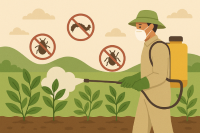


Single-pest sprays miss hidden threats—dual-action solutions save time, cost, and protect yield.
Why Single-Pest Treatments Waste Time, Money, and Yield
No, because infestations are rarely isolated in the field, single-pest therapies are ineffective. The majority of crops require broader-spectrum treatment because various pest species attack them at different phases of growth.
Key fact: According to ICAR, 73% of pest outbreaks in major crops involve more than one pest species at a time.
Three primary failures weaken single-target solutions:
|
Failure Mode |
Impact on Crop Protection |
| Partial spectrum control |
Leaves other pests unchecked |
|
Non-systemic chemistry |
Misses internal pests like larvae |
| Uncoordinated spray timing |
Causes resurgence and resistance development |
Multiple pests become critical during overlapping phenological stages—flowering, fruiting, and early vegetative growth. The timing of the spray, not just the target, determines success.
Case study: In tomatoes, whiteflies damage leaves while fruit borers attack the forming tomatoes. Treating late results in scarring, curling, and yield loss.
Dual-action insecticides combine contact and systemic activity, targeting a wider pest spectrum in one spray. For example:
|
Component |
Pest Type Targeted | Mode of Action |
| Beta-Cyfluthrin | Chewing pests (e.g., caterpillars) |
Fast-acting, contact knockdown |
|
Imidacloprid |
Sucking pests (e.g., aphids) |
Systemic, long-lasting protection |
Benefits include:
Switching to dual-active products reduces cost and increases yield.
|
Metric |
Narrow-Spectrum Sprays | Broad-Spectrum Combo |
| Seasonal Spray Cost | ₹4,200/acre |
₹3,300/acre |
|
Yield Increase |
— | +14% |
| Insecticide Use (kg/acre) | 3.6 |
2.4 |
Source: ICAR study on cotton (2023)
Climate change and monocultures accelerate pest evolution:
This demands adaptive strategies with flexible chemistry and ecological alignment.
Smart application maximizes benefits and reduces risk. Key practices:
Pro tip: Don’t mix products with similar active ingredients. Always check compatibility labels before tank mixing.
Yes, when used correctly. They:
However, overuse or misuse can still harm non-target organisms and soil microbes. Always follow threshold-based applications.
Additional operational benefits include:
Dual-action products often include enhanced surfactants for better leaf adhesion and rainfastness.
Yes, but the risk is lower if rotation protocols are followed. Warning signs include:
Always track performance using scouting logs and consult with local agronomists or IRAC updates.
|
Question |
Answer |
| Can I use single and combo sprays together? |
Yes, if the modes of action differ. Never stack similar chemistry. |
|
Are dual-action products safe for bees? |
Most are, if applied when bees are inactive. Avoid flowering periods. |
| Do these products hurt soil? |
Not if used as directed. Avoid overuse to protect microbial balance. |
|
What if my pest isn’t covered by these actives? |
Use targeted biological or chemical alternatives for mites or nematodes. |
| How do I know if pests are becoming resistant? |
Monitor control decline over time. Increase in pest survival is a red flag. |
Integrated, dual-action insecticides offer faster control, longer protection, and fewer spray cycles. They’re built for today’s complex pest pressures, not yesterday’s assumptions.
Rather than chasing pests one by one, modern strategies focus on protecting crops across stages with more innovative tools.
Efficient pest control isn’t about more spraying—it’s about better targeting with fewer inputs.
